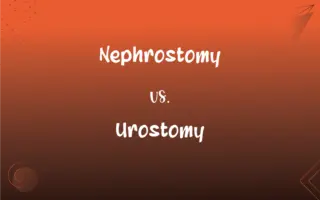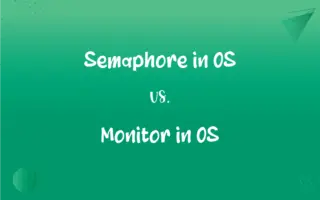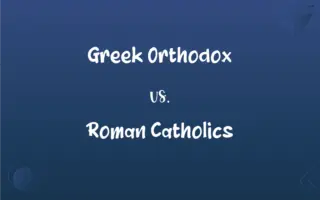PVC vs. Vinyl: What's the Difference?
By Aimie Carlson & Janet White || Published on March 7, 2024
PVC, or polyvinyl chloride, is a durable thermoplastic made from vinyl chloride monomers, used in construction and plumbing. Vinyl refers broadly to vinyl group-containing compounds, including PVC, emphasizing the material's versatility.

Key Differences
PVC and vinyl are related terms in the world of polymers, with PVC being a specific type of vinyl polymer. PVC, standing for polyvinyl chloride, is made by polymerizing vinyl chloride monomers, resulting in a strong, resistant material widely used in construction for pipes, window frames, and as insulation on wires. Vinyl, on the other hand, refers to any compound containing the vinyl group, a kind of ethylene molecule where one hydrogen atom is replaced by another group. This broad category includes PVC but also encompasses a wide variety of other materials, such as polyvinyl acetate (PVA), used in adhesives, and polyvinyl alcohol (PVOH), used in packaging films.
The difference between PVC and vinyl often lies in the context of their use. PVC is specifically used when referring to the polymer used in construction and plumbing, known for its rigidity and durability. Vinyl is a more general term that can refer to PVC when discussing flooring, siding, or records, highlighting the material's flexibility and adaptability to various applications.
From an environmental perspective, PVC has been scrutinized for its production and disposal challenges, including the release of harmful chemicals. Vinyl products, depending on their specific composition, also face similar environmental concerns, particularly around recycling and lifecycle management.
In terms of manufacturing, PVC requires specific processes including polymerization of vinyl chloride, while vinyl products can be made from various polymerization processes depending on the desired properties of the final product. This versatility makes vinyl a popular choice in industries ranging from automotive to healthcare.
Comparison Chart
Definition
A durable thermoplastic made from polymerizing vinyl chloride monomers.
Refers to any compound containing the vinyl group, including PVC.
ADVERTISEMENT
Uses
Construction (pipes, window frames), electrical insulation, medical equipment.
Flooring, records, siding, adhesives, packaging films.
Material Properties
Rigid, durable, chemical resistant, excellent insulator.
Versatile, can be flexible or rigid, chemical resistant, varies by specific polymer.
Environmental Impact
Concerns over production and disposal, release of harmful chemicals.
Similar concerns, with variability based on the specific type of vinyl compound.
Manufacturing Process
Polymerization of vinyl chloride.
Various polymerization processes, depending on the specific vinyl compound.
PVC and Vinyl Definitions
PVC
Used in healthcare for medical devices due to its flexibility and safety.
PVC is used in blood bags and tubing for its non-reactivity.
ADVERTISEMENT
Vinyl
A versatile material category that includes polymers like PVC, PVA, and PVOH.
Vinyl records are prized for their sound quality.
PVC
Known for its durability and chemical resistance, making it ideal for outdoor applications.
PVC window frames resist weathering and corrosion.
Vinyl
Used in a wide range of applications from construction materials to consumer goods.
Vinyl flooring is popular for its durability and ease of maintenance.
PVC
A thermoplastic polymer made by polymerizing vinyl chloride, used in construction.
PVC pipes are widely used for plumbing in residential and commercial buildings.
Vinyl
Can be engineered for flexibility or rigidity, depending on the application.
Vinyl banners are flexible and durable for outdoor advertising.
PVC
Faces environmental scrutiny, particularly regarding its disposal.
PVC recycling programs aim to reduce its environmental impact.
Vinyl
The production process varies, tailored to the specific type of vinyl material.
Vinyl adhesives are formulated for specific bonding strengths and drying times.
PVC
Can be made more flexible with the addition of plasticizers.
Flexible PVC is used in electrical cable insulation.
Vinyl
Environmental considerations vary widely across vinyl products.
Recycling programs are expanding to include more vinyl products.
PVC
A polymer of vinyl chloride used instead of rubber in electric cables
Vinyl
The univalent hydrocarbon group CH2=CH, derived from ethylene.
PVC
Irregularity of cardiac rhythm; recurrent occurrences can be a precursor of ventricular fibrillation
Vinyl
Any of various compounds containing the vinyl group, typically highly reactive, easily polymerized, and used as basic materials for plastics.
FAQs
Can PVC be considered a type of vinyl?
Yes, PVC is a specific type of vinyl polymer, characterized by its use in rigid applications such as pipes and window frames.
How are vinyl products recycled?
Recycling processes vary depending on the type of vinyl, but generally include mechanical recycling, feedstock recycling, and energy recovery, with ongoing research into more efficient methods.
Can vinyl be used outdoors?
Yes, certain types of vinyl, including PVC, are designed for outdoor use, offering resistance to weathering and UV radiation.
Are PVC and vinyl environmentally friendly?
Both face environmental challenges related to production, use, and disposal, with efforts underway to improve recycling and reduce harmful emissions.
Why is PVC considered durable?
PVC's chemical structure provides high resistance to chemicals, weathering, and physical impacts, making it exceptionally durable for long-term use in various environments.
What is the main difference between PVC and vinyl?
PVC is a specific type of vinyl polymer known for its use in construction and plumbing, while vinyl refers to any compound containing the vinyl group, encompassing a wide range of materials including PVC.
Is all vinyl flexible?
Not all vinyl is flexible; the material's properties can be adjusted through the use of additives and different polymerization processes to meet specific needs.
How does the vinyl group influence the properties of polymers?
The vinyl group allows for a wide range of polymerization reactions, influencing the flexibility, durability, and chemical resistance of the resulting polymers.
What are the health concerns associated with PVC?
Concerns include the release of toxic chemicals during manufacture and disposal, such as dioxins, and the use of phthalates as plasticizers, which have been linked to health issues.
What are the key factors in choosing between PVC and other vinyl materials?
Factors include the specific application requirements such as flexibility, durability, chemical resistance, and environmental impact considerations.
Are there any biodegradable vinyl materials?
Research is ongoing to develop biodegradable forms of vinyl materials, though traditional vinyl compounds like PVC are not typically biodegradable.
Why is PVC used in medical devices?
PVC's flexibility, durability, and non-reactivity make it suitable for a variety of medical devices, including tubing and blood bags.
What makes vinyl flooring popular?
Its durability, ease of maintenance, and versatility in designs make vinyl flooring a popular choice for both residential and commercial applications.
How is PVC recycled?
PVC is recycled through mechanical recycling, where it is ground into small pieces and then reprocessed into new products, and chemical recycling, breaking it down into its chemical components.
How does the production of PVC and vinyl impact health?
The production of PVC and some vinyl compounds can release harmful chemicals; however, regulations and industry improvements aim to minimize these impacts.
What innovations are being made in vinyl technology?
Innovations include the development of non-toxic plasticizers, improved recycling methods, and the creation of more sustainable forms of vinyl polymers.
Can PVC and other vinyl materials be printed on?
Yes, both PVC and other vinyl materials are commonly used in printing for signs, banners, and wraps due to their durability and excellent ink adhesion.
What are the future prospects for PVC and vinyl materials?
The future of PVC and vinyl materials involves enhancing sustainability through green chemistry, improving recyclability, and reducing the environmental impact of production and disposal.
What role does PVC play in energy efficiency?
PVC is used in insulation for electrical wires, contributing to energy efficiency, and in windows and doors as an effective insulator, helping to reduce energy costs.
How are vinyl materials used in the automotive industry?
Vinyl is used in the automotive industry for car seats, dashboards, and exterior wraps, offering durability, flexibility, and aesthetic appeal.
About Author
Written by
Aimie CarlsonAimie Carlson, holding a master's degree in English literature, is a fervent English language enthusiast. She lends her writing talents to Difference Wiki, a prominent website that specializes in comparisons, offering readers insightful analyses that both captivate and inform.
Co-written by
Janet WhiteJanet White has been an esteemed writer and blogger for Difference Wiki. Holding a Master's degree in Science and Medical Journalism from the prestigious Boston University, she has consistently demonstrated her expertise and passion for her field. When she's not immersed in her work, Janet relishes her time exercising, delving into a good book, and cherishing moments with friends and family.







































































